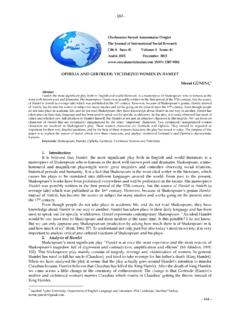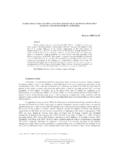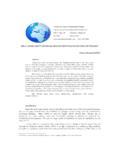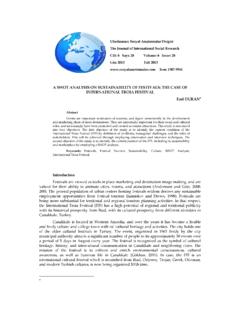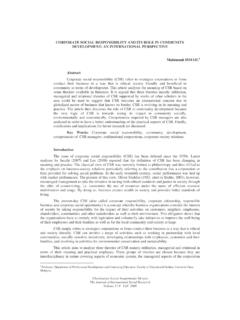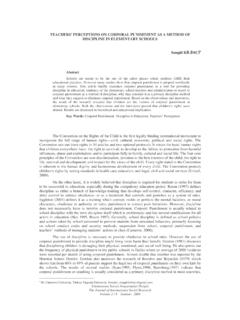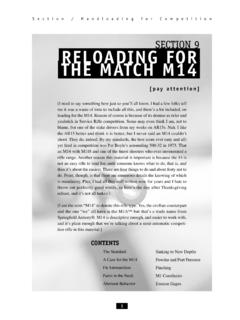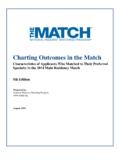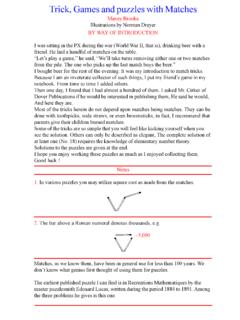Transcription of A Review on the Relationship between …
1 A Review on the Relationship between organizational Resources, competitive Advantage and Performance Raduan Che ROSE*1 Haslinda ABDULLAH**2 Alimin Ismail ISMAD**3 Abstract Understanding sources of sustained competitive advantage has become a major area of study in strategic management. The resource -based view stipulates that in strategic management the fundamental sources and drivers to firms competitive advantage and superior performance are mainly associated with the attributes of their resources which are valuable and costly-to-copy. As such, in order to achieve a competitive advantage level that not only can at least match those of their business rivals but also will be able to exceed the industrial performance averages, business organizations have to initially seek understanding as to the relative degree of Relationship between their organizational internal resources, competitive advantage and performance.
2 Such a research can contribute to the body of knowledge by lending empirical support and further extending the RBV of competitive advantage by examining the relative magnitude of importance placed upon organizational resources towards attaining competitive advantage and enhancing firm s performance. Key Words: organizational resources, competitive advantage and performance; resource -based view Introduction The pursuit of firms competitive advantage is indeed an idea that is at the heart of much of the strategic management literature (Burden and Proctor, 2000; Fahy, 2000; Ma, 2000, 2004; Barney, 2001a, 2001b, 2007; Lin, 2003; Fahy, Farrelly and Quester, 2004; Cousins, 2005; Porter and Kramer, 2006; Liao and Hu, 2007).
3 Understanding sources of sustained competitive advantage has become a major area of study in strategic management (Porter, 1985, 1991; Barney, 1991; Peteraf, 1993; Ma, 1999a, 1999b, 2004; Flint and Van Fleet, 2005; King, 2007). The resource -based view stipulates that in strategic management the fundamental sources and drivers to firms competitive advantage and superior performance are mainly associated with the attributes of their resources which are valuable and costly-to-copy (Barney, 1986, 1991, 2001a; Conner, 1991; Mills, Platts and Bourne, 2003; Peteraf and Bergen, 2003). As such, in order to achieve a competitive advantage level that not only can at least match those of their business rivals but also will be able to exceed the industrial performance averages, business organizations have to initially seek understanding as to the relative degree of Relationship between their organizational internal resources, competitive advantage and performance.
4 By having essential information on the relative internal strengths and weaknesses of their organizational resources, management can be guided in the process of making strategic business decision in order to improve their overall organizational position. competitive Advantage Building on the assumptions that strategic resources are heterogeneously distributed across firms and that these differences are stable overtime, Barney (1991) examines the link between firm s resources and sustained competitive advantage. Four empirical indicators of the potential of firm s resources to generate sustained competitive advantage value, rareness, inimitability, and non-substitutability are discussed. The model is applied by analyzing the potential of several firms resources for generating sustained *1 Professor, Faculty of Economics & Management, Universiti Putra Malaysia, 43400 Selangor, Malaysia, **2 Associate Professor, Faculty of Economics & Management, Universiti Putra Malaysia, 43400 Selangor, Malaysia, **3 Corresponding Author, Graduate School of Management, Universiti Putra Malaysia, 43400 Selangor, Malaysia, Uluslararas Sosyal Ara t rmalar Dergisi The Journal of International Social Research Volume 3 / 11 Spring 2010 489 competitive advantages.
5 The article concludes by examining implications of firms resource model of sustained competitive advantage for other business disciplines. In Barney (1991), firms resources include all assets, capabilities, organizational processes, firm s attributes, information, knowledge, etc. controlled by a firm that enables the firm to conceive and implement strategies to improve its efficiency and effectiveness. In this article, a firm is said to have a competitive advantage when it is implementing a value creating strategy not simultaneously being implemented by any current or potential competitors. Furthermore, a firm is said to have a sustained competitive advantage when it is implementing a value creating strategy not simultaneously being implemented by any current or potential competitors and when these other firms are unable to duplicate the benefits of this strategy (Barney, 1991).
6 Barney (1991) further argues that to have the potential to generate competitive advantage, a firm s resource must have four attributes: (a) it must be valuable, in the sense that it exploits opportunities and/or neutralizes threats in a firm s environment; (b) it must be rare among a firm s current and potential competition; (c) it must be imperfectly imitable; and (d) there cannot be strategically equivalent substitutes for this resource . competitive advantage is perhaps the most widely used term in strategic management, yet it remains poorly defined and operationalized (Ma, 2000). Ma (2000) makes three observations regarding competitive advantage and conceptually explores the various patterns of Relationship between competitive advantage and firm s performance, namely: (i) competitive advantage does not equate to superior performance; (ii) competitive advantage is a relational term; and (iii) competitive advantage is context-specific.
7 In addition, Ma (2000) further examines three patterns of Relationship between competitive advantage and firm s performance, namely: (i) competitive advantage leading to superior performance; (ii) competitive advantage without superior performance; and (iii) superior performance without competitive advantage. The ultimate purpose of Ma s (2000) article is to help generate a healthy debate among strategy scholars on the usefulness of the competitive advantage construct for our theory building and testing. Ma (1999b) has also argued that competitive advantage arises from the differential among firms along any dimension of firm s attributes and characteristics that allows one firm to better create customer value than do others.
8 Generic sources of competitive advantage include ownership of assets or position; access to distribution and supply; as well as proficiency knowledge, competence, and capability in business operation. It has also been further argued that in order to achieve and sustain competitive advantage, a firm needs to creatively and proactively exploit the three generic sources, preempt rivals attempt at these sources, and/or pursue any combination of proactive and preemptive effort. This article advances an integrative framework that helps management practitioners to systematically analyze the nature and cause of competitive advantage (Ma, 1999b). competitive advantage is the basis for superior performance (Ma, 1999a). Understanding the anatomy of competitive advantage is of paramount importance to general managers who bear the ultimate responsibility for a firm s long term survival and success.
9 Ma (1999a) advances an integrative framework called SELECT to help general managers systematically examine the various facets of the anatomy of competitive advantage: its substance, expression, locale, effect, cause, and time-span. It has been reasoned that by analyzing the causes of competitive advantage helps a firm create and gain advantage. Studying the substance, expression, locale, and effect of competitive advantage allows the firm to better utilize the advantage. Examining the time span of competitive advantage enables the firm to fully exploit the advantage according to its potential and sustainability (Ma, 1999a). The resource -based view of the firm (RBV) has emerged in recent years as a popular theory of competitive advantage.
10 The term was originally coined by Wernerfelt in 1984 (Fahy, 2000) and the significance of this contribution is evident in it being awarded the Strategic Management Journal best paper prize in 1994 for reasons such as being truly seminal and an early statement of an important trend in the field (Zajac, 1995; cited in Fahy, 2000). Fahy (2000) reasoned that the principal contribution of the resource -based view of the firm has been as a theory of competitive advantage. Its basic logic is a relatively simple one. It starts with the assumption that the desired outcome of managerial effort within the firm is a sustainable competitive advantage (SCA). Uluslararas Sosyal Ara t rmalar Dergisi The Journal of International Social Research Volume 3 / 11 Spring 2010 490 Achieving an SCA allows the firm to earn economic rents or above-average returns.
